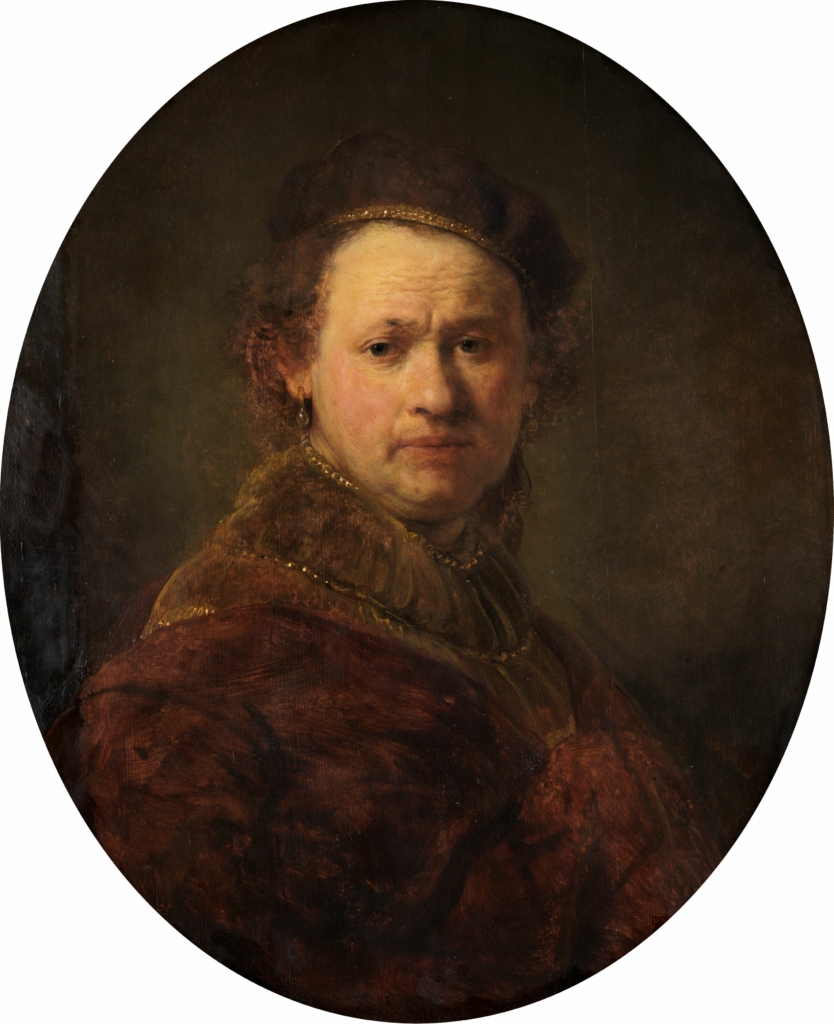
| X (Twitter) | |
|---|---|
URL kopieren
Die URL wurde erfolgreich kopiert und befindet sich in der Zwischenablage |
|
Im Zuge des Website-Relaunchs finden Sie hier vorerst keine hochauflösenden Abbildungen. Im Hintergrund arbeiten wir daran, sie Ihnen an dieser Stelle schnellstmöglich präsentieren zu können. Bis dahin wenden Sie sich gerne per Mail an digital@kunsthalle-karlsruhe.de, wenn Sie Abbildungen in hoher Auflösung benötigen.
Self-Portrait
Rembrandt Harmenszoon van Rijn
H 59.5cm W 73.5cm
around 1645/48
KunsthalleKarlsruhe@ZKM
Description
Something that is typical of Rembrandt is the different degrees of elaboration within his paintings. While the facial features are finely modelled in detail, his coat is merely outlined. This gives the state of mind captured in the face an immense presence. In his numerous self-portraits, however, Rembrandt obviously did not have the analysis of himself in mind. Rather, he wanted to paint gripping, and thus marketable, pictures. At which he was very successful, for his self-portraits became sought-after collector’s items far beyond his own lifetime.
Who is Who
0:00
0:00
Raphael, Michelangelo, Titian, Rembrandt. Do you notice anything? Yes, of course, they are all great names, important in the history of art, but which part of them? That’s right: they are all just first names that have been engraved on our collective memory of names. Or could you name the last names of all four artists off the top of your head?
Branding anno 1631
By using this trick and making Rembrandt Harmeszoon van Rijn simply Rembrandt, the painter of the self-portrait not only joined the ranks of the greats; he also developed his own branding, created a recognisable trademark: if it says Rembrandt on it, then a Rembrandt is what it is! And when the artist finally came to run his own studio, it went without saying that the works of his assistants also carried his name — for as long as they did not have the status of master.
The 17th century dutch customer
The fact that the artist, newly arrived in Amsterdam in 1631, even thought of developing such a trademark was because of the general conditions prevailing at that time in his profession. Art production in the northern Dutch provinces reacted to the lack of ecclesiastical and also aristocratic patrons, which was due to the religious and political situation: the artists adapted their works to the interests of other potential buyers who were mainly middle class. A free market emerged, in which an immense supply met with an equally immense demand: in the heyday of Dutch painting during the mid-17th century, some 70,000 paintings were produced there each year.
The essence of the brand
In order not to sink under this deluge as a nameless person, not only a good signet was needed, but also a recognisable brand core. Rembrandt created these above all by setting himself apart from his painter competitors, and by breaking with conventions, established painting methods, and compositional patterns. Surprisingly, he did not specialise in still lifes, portraits, or seascapes like many of his contemporaries — he was in demand as an all-rounder.
Billboard Rembrandt
Rembrandt’s brand included first and foremost his own likeness, which he featured over and over again, depicting himself in all conceivable moods, in the most diverse arrangements, and even inserted into history paintings. Thus recognisability was and is a given on several levels, for contemporaries as well as for those interested in the history of art today.
Dates and facts
| Title | Self-Portrait |
|---|---|
| Artist | Rembrandt |
| Date | around 1645/48 |
| Measurement Painting | H 73.5cm W 59.5cm D 0.8cm |
| Material |